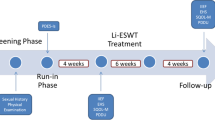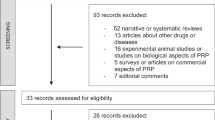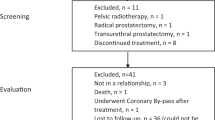Abstract
The impact of energy flux density (EFD) used on low-intensity shockwave therapy (LiST) for erectile dysfunction (ED) has not been explored. Our aim was to compare EFD 0.05 versus 0.10 mJ/mm2 regarding efficacy and safety of 12-treatment sessions when applied two or three times per week. Ninety-seven patients with vasculogenic ED, PDE5 inhibitors users were randomized into four groups, to receive 12 LiST sessions. Group A (n = 24) : two sessions per week, EFD 0.05 mJ/mm2; Group B (n = 24): three sessions per week, EFD 0.05 mJ/mm2; Group C (n = 24): two sessions per week, EFD 0.10 mJ/mm2; Group D (n = 25): three sessions per week, EFD 0.10 mJ/mm2. International Index for Erectile Function—Erectile Function domain (IIEF-EF), Minimally clinical important differences (MCID), sexual encounter profile, and triplex ultrasonography parameters were used to asses erectile function. Eighty-nine patients completed the 6-month follow-up (FU). All four groups improved in mean IIEF-EF score, average SEP3 “Yes” response rates at 6-month FU visit compared with baseline (p < 0.001). MCID at 6-month FU visit was achieved in 82.6%, 77.3%, 87%, and 81% in Groups A, B, C, and D, respectively. Mean PSV (cm/s) at baseline versus 3-month FU visit were 30.32 versus 34.67 for Group A, 30.02 versus 35.02 for Group B, 30.2 versus 36.02, for Group C, 29.43 versus 34.3 for Group D (p < 0.01). There were no statistical significant differences in the change of all outcome measures assessing erectile function between different sessions frequency. A tendency for better efficacy using EFD 0.10 mJ/mm2 was noticed, although it did not reach statistical significance. No treatment-related side‐effects were reported. This study lacks a sham-controlled arm. However, all patients were randomized to the four groups, and baseline characteristics were similar between the groups. Moreover, arterial insufficiency was confirmed among all patients by penile triplex ultrasonography. Conclusively, patients may benefit equally when sessions are applied either two or three per week. An EFD of 0.10 mJ/mm2 could result in better outcomes, but further studies are needed to validate this observation.
This is a preview of subscription content, access via your institution
Access options
Subscribe to this journal
Receive 8 print issues and online access
$259.00 per year
only $32.38 per issue
Buy this article
- Purchase on Springer Link
- Instant access to full article PDF
Prices may be subject to local taxes which are calculated during checkout



Similar content being viewed by others
References
Gruenwald I, Appel B, Vardi Y. Low-intensity extracorporeal shock wave therapy–a novel effective treatment for erectile dysfunction in severe ED patients who respond poorly to PDE5 inhibitor therapy. J Sex Med. 2012;9:259–64.
Kitrey ND, Gruenwald I, Appel B, Shechter A, Massarwa O, Vardi Y. Penile low intensity shock wave treatment is able to shift PDE5i nonresponders to responders: a double-blind, sham controlled study. J Urol. 2016;195:1550–5.
Vardi Y, Appel B, Kilchevsky A, Gruenwald I. Does low intensity extracorporeal shock wave therapy have a physiological effect on erectile function? Short-term results of a randomized, double-blind, sham controlled study. J Urol. 2012;187:1769–75.
Kalyvianakis D, Hatzichristou D. Low-intensity shockwave therapy improves hemodynamic parameters in patients with vasculogenic erectile dysfunction: a triplex ultrasonography-based sham-controlled trial. J Sex Med. 2017;14:891–7.
Sokolakis I, Hatzichristodoulou G. Clinical studies on low intensity extracorporeal shockwave therapy for erectile dysfunction: a systematic review and meta-analysis of randomised controlled trials. Int J Impot Res. 2019;31:177–94.
Kalyvianakis D, Memmos E, Mykoniatis I, Kapoteli P, Memmos D, Hatzichristou D. Low-intensity shockwave therapy for erectile dysfunction: a randomized clinical trial comparing 2 treatment protocols and the impact of repeating treatment. J Sex Med. 2018;15:334–45.
Cappelleri JC, Rosen RC, Smith MD, Mishra A, Osterloh IH. Diagnostic evaluation of the erectile function domain of the International Index of Erectile Function. Urology. 1999;54:346–51.
Benson CB, Aruny JE, Vickers MA Jr. Correlation of duplex sonography with arteriography in patients with erectile dysfunction. AJR Am J Roentgenol. 1993;160:71–3.
Rosen RC, Allen KR, Ni X, Araujo AB. Minimal clinically important differences in the erectile function domain of the International Index of Erectile Function scale. Eur Urol. 2011;60:1010–6.
Yafi FA, Jenkins L, Albersen M, Corona G, Isidori AM, Goldfarb S, et al. Erectile dysfunction. Nat Rev Dis Prim. 2016;2:16003.
Young Academic Urologists Men’s Health G, Fode M, Hatzichristodoulou G, Serefoglu EC, Verze P, Albersen M. Low-intensity shockwave therapy for erectile dysfunction: is the evidence strong enough? Nat Rev Urol. 2017;14:593–606.
Hatzichristou D. Low-intensity extracorporeal shock waves therapy (LI-ESWT) for the treatment of erectile dysfunction: where do we stand? Eur Urol. 2017;71:234–6.
Qiu X, Lin G, Xin Z, Ferretti L, Zhang H, Lue TF, et al. Effects of low-energy shockwave therapy on the erectile function and tissue of a diabetic rat model. J Sex Med. 2013;10:738–46.
Clavijo RI, Kohn TP, Kohn JR, Ramasamy R. Effects of low-intensity extracorporeal shockwave therapy on erectile dysfunction: a systematic review and meta-analysis. J Sex Med. 2017;14:27–35.
Schoofs E, Fode M, Capogrosso P, Albersen M. For the European association of urology young academic urologists men’s health G. Current guideline recommendations and analysis of evidence quality on low-intensity shockwave therapy for erectile dysfunction. Int J Impot Res. 2019;31:209–17.
Yang H, Seftel AD. Controversies in low intensity extracorporeal shockwave therapy for erectile dysfunction. Int J Impot Res. 2019;31:239–42.
Vardi Y, Appel B, Jacob G, Massarwi O, Gruenwald I. Can low-intensity extracorporeal shockwave therapy improve erectile function? A 6-month follow-up pilot study in patients with organic erectile dysfunction. Eur Urol. 2010;58:243–8.
Musicki B, Bella AJ, Bivalacqua TJ, Davies KP, DiSanto ME, Gonzalez-Cadavid NF, et al. Basic science evidence for the link between erectile dysfunction and cardiometabolic dysfunction. J Sex Med. 2015;12:2233–55.
Cellek S, Cameron NE, Cotter MA, Muneer A. Pathophysiology of diabetic erectile dysfunction: potential contribution of vasa nervorum and advanced glycation endproducts. Int J Impot Res. 2013;25:1–6.
Echeverri Tirado LC, Ferrer JE, Herrera AM. Aging and erectile dysfunction. Sex Med Rev. 2016;4:63–73.
Sokolakis I, Dimitriadis F, Teo P, Hatzichristodoulou G, Hatzichristou D, Giuliano F. The basic science behind low-intensity extracorporeal shockwave therapy for erectile dysfunction: a systematic scoping review of pre-clinical studies. J Sex Med. 2019;16:168–94.
Liu T, Shindel AW, Lin G, Lue TF. Cellular signaling pathways modulated by low-intensity extracorporeal shock wave therapy. international journal of impotence research. Int J Impot Res. 2019;31:170–6.
Sokolakis I, Dimitriadis F, Psalla D, Karakiulakis G, Kalyvianakis D, Hatzichristou D. Effects of low-intensity shock wave therapy (LiST) on the erectile tissue of naturally aged rats. Int J Impot Res. 2019;31:162–9.
Gruenwald I, Spector A, Shultz T, Lischinsky D, Kimmel E. The beginning of a new era: treatment of erectile dysfunction by use of physical energies as an alternative to pharmaceuticals. Int J Impot Res. 2019;31:155–61.
Funding
This study was made possible by an investigator-initiated research grant from Dornier MedTech Systems, GmbH (Wessling, Germany)
Author information
Authors and Affiliations
Corresponding author
Ethics declarations
Conflict of interest
The authors declare that they have no conflict of interest.
Additional information
Publisher’s note: Springer Nature remains neutral with regard to jurisdictional claims in published maps and institutional affiliations.
Rights and permissions
About this article
Cite this article
Kalyvianakis, D., Mykoniatis, I., Memmos, E. et al. Low-intensity shockwave therapy (LiST) for erectile dysfunction: a randomized clinical trial assessing the impact of energy flux density (EFD) and frequency of sessions. Int J Impot Res 32, 329–337 (2020). https://doi.org/10.1038/s41443-019-0185-0
Received:
Revised:
Accepted:
Published:
Issue Date:
DOI: https://doi.org/10.1038/s41443-019-0185-0
This article is cited by
-
Conservative Non-surgical Options for Erectile Dysfunction
Current Urology Reports (2023)
-
The penile ultrasound study: an unnecessary exam or an ace in the hole?
International Journal of Impotence Research (2022)
-
Can low intensity shockwave therapy match the efficacy of phosphodiesterase-5 inhibitors for erectile dysfunction treatment? A pooled data analysis from two randomized clinical trials
International Journal of Impotence Research (2021)



